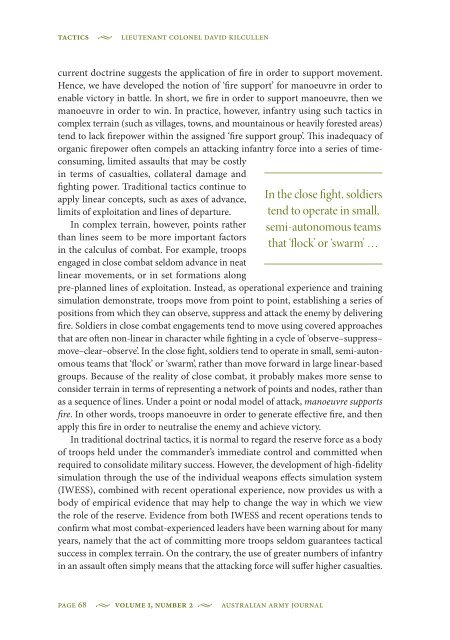The Essential Debate: Combined Arms and the ... - Australian Army
The Essential Debate: Combined Arms and the ... - Australian Army
The Essential Debate: Combined Arms and the ... - Australian Army
Create successful ePaper yourself
Turn your PDF publications into a flip-book with our unique Google optimized e-Paper software.
Tactics Lieutenant Colonel David Kilcullencurrent doctrine suggests <strong>the</strong> application of fire in order to support movement.Hence, we have developed <strong>the</strong> notion of ‘fire support’ for manoeuvre in order toenable victory in battle. In short, we fire in order to support manoeuvre, <strong>the</strong>n wemanoeuvre in order to win. In practice, however, infantry using such tactics incomplex terrain (such as villages, towns, <strong>and</strong> mountainous or heavily forested areas)tend to lack firepower within <strong>the</strong> assigned ‘fire support group’. This inadequacy oforganic firepower often compels an attacking infantry force into a series of timeconsuming,limited assaults that may be costlyin terms of casualties, collateral damage <strong>and</strong>fighting power. Traditional tactics continue toapply linear concepts, such as axes of advance,limits of exploitation <strong>and</strong> lines of departure.In complex terrain, however, points ra<strong>the</strong>rthan lines seem to be more important factorsin <strong>the</strong> calculus of combat. For example, troopsengaged in close combat seldom advance in neatlinear movements, or in set formations alongIn <strong>the</strong> close fight, soldierstend to operate in small,semi-autonomous teamsthat ‘flock’ or ‘swarm’ …pre-planned lines of exploitation. Instead, as operational experience <strong>and</strong> trainingsimulation demonstrate, troops move from point to point, establishing a series ofpositions from which <strong>the</strong>y can observe, suppress <strong>and</strong> attack <strong>the</strong> enemy by deliveringfire. Soldiers in close combat engagements tend to move using covered approachesthat are often non-linear in character while fighting in a cycle of ‘observe–suppress–move–clear–observe’. In <strong>the</strong> close fight, soldiers tend to operate in small, semi-autonomousteams that ‘flock’ or ‘swarm’, ra<strong>the</strong>r than move forward in large linear-basedgroups. Because of <strong>the</strong> reality of close combat, it probably makes more sense toconsider terrain in terms of representing a network of points <strong>and</strong> nodes, ra<strong>the</strong>r thanas a sequence of lines. Under a point or nodal model of attack, manoeuvre supportsfire. In o<strong>the</strong>r words, troops manoeuvre in order to generate effective fire, <strong>and</strong> <strong>the</strong>napply this fire in order to neutralise <strong>the</strong> enemy <strong>and</strong> achieve victory.In traditional doctrinal tactics, it is normal to regard <strong>the</strong> reserve force as a bodyof troops held under <strong>the</strong> comm<strong>and</strong>er’s immediate control <strong>and</strong> committed whenrequired to consolidate military success. However, <strong>the</strong> development of high-fidelitysimulation through <strong>the</strong> use of <strong>the</strong> individual weapons effects simulation system(IWESS), combined with recent operational experience, now provides us with abody of empirical evidence that may help to change <strong>the</strong> way in which we view<strong>the</strong> role of <strong>the</strong> reserve. Evidence from both IWESS <strong>and</strong> recent operations tends toconfirm what most combat-experienced leaders have been warning about for manyyears, namely that <strong>the</strong> act of committing more troops seldom guarantees tacticalsuccess in complex terrain. On <strong>the</strong> contrary, <strong>the</strong> use of greater numbers of infantryin an assault often simply means that <strong>the</strong> attacking force will suffer higher casualties.page 68 Volume I, Number 2 <strong>Australian</strong> <strong>Army</strong> Journal
















